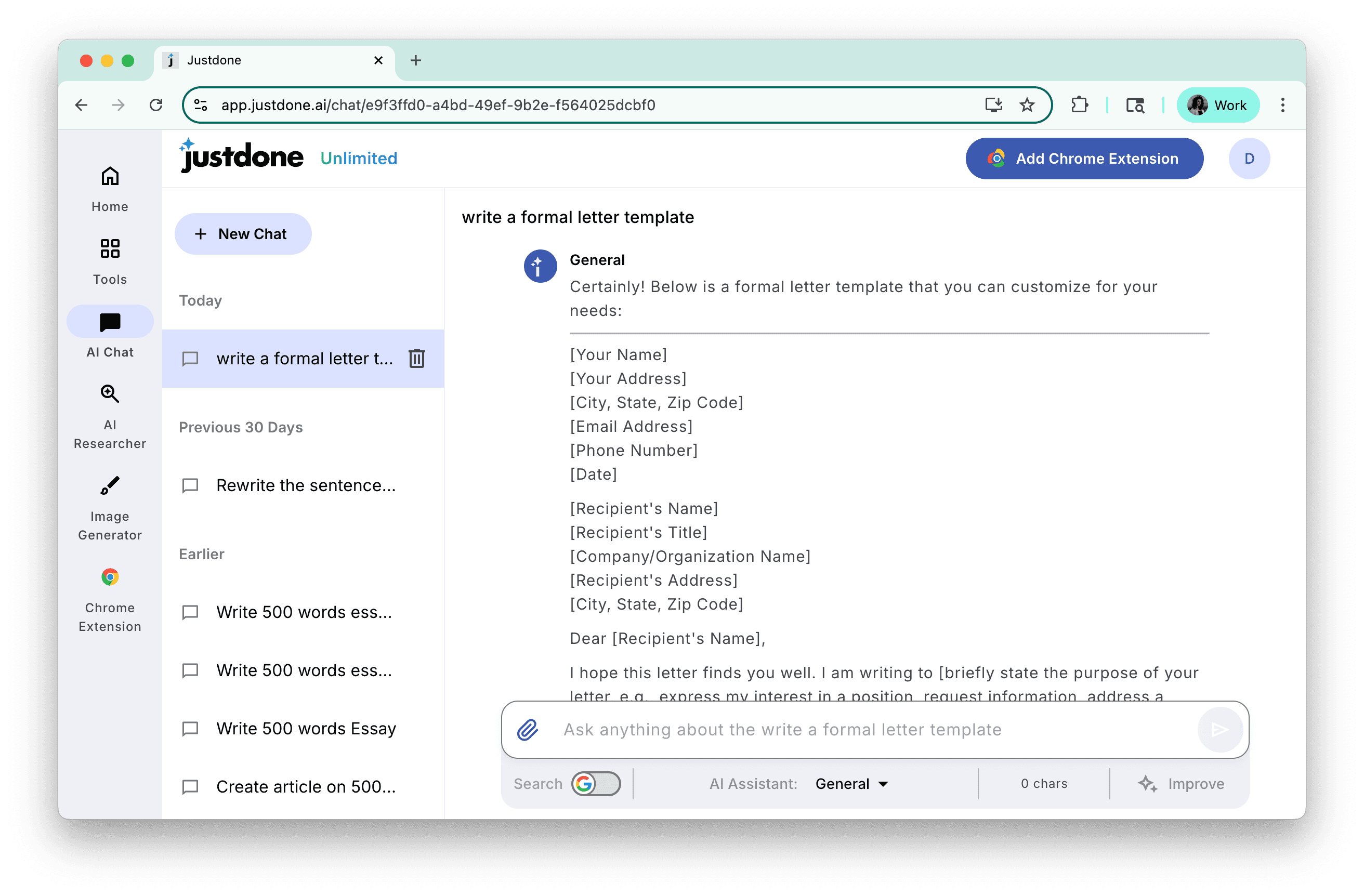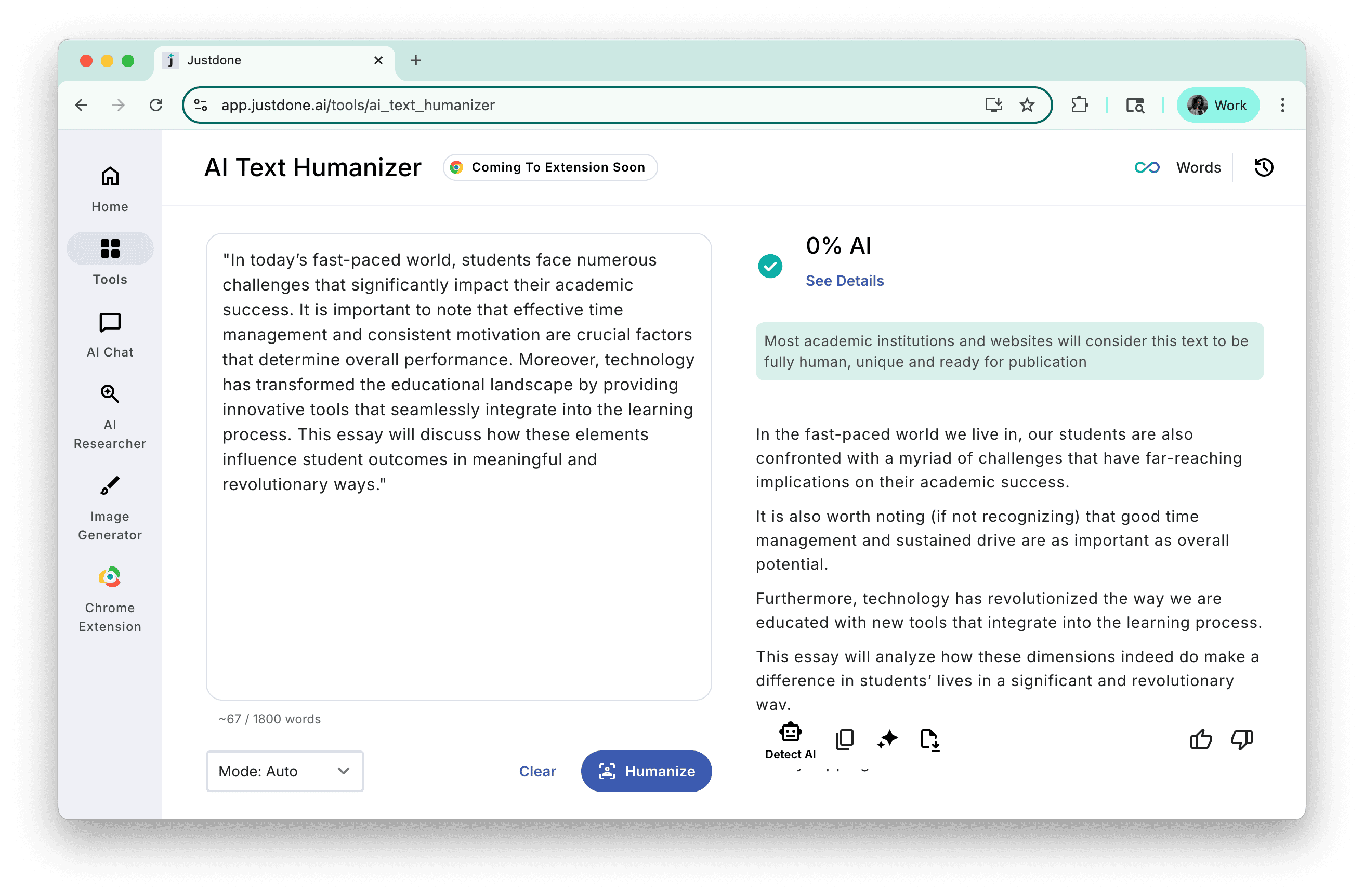Writing a formal letter often feels intimidating, especially when you are a student with little experience in business communication. In professional and academic spheres, formal letters contribute to the first impression, so it is highly important to know how to write formal letters correctly. In this guide, you will explore several types of formal letters, the reasons why you need to write them, and the proper structure to use. We will also equip you with the best-working formal letter template generated with the help of JustDone's AI letter generator, AI Humanizer, and Paraphraser. Let’s get started!

When to Use a Formal Letter Format
There are different situations where the formal letter is essential. Whether you need to engage with a professor, apply for a position, or get official feedback on your request, it’s important to know when to adopt a formal tone.
Here are some scenarios:
- Applying for a job or internship
- Requesting a reference or recommendation
- Corresponding with a school or university
- Addressing complaints or feedback
- Making inquiries to businesses or organizations
You can use AI writing assistants to simplify your formal letter writing. For example, JustDone's AI letter generator can help you draft these letters effortlessly, ensuring that you maintain a formal tone and proper structure appropriate for your audience. Here's how your draft can look:

Top 10 Types of Formal Letters
Understanding the different types of formal letters is crucial for effective communication. Depending on the content, formal letters are divided into the following groups: informational, notification, accompanying, guarantee, claim, request, response, invitation, and many others. They differ in purpose, meaning, and addressee.
For example, informational letters are for management or other responsible people to send official materials like regulatory documents, rules of conduct, appendices, etc. These letters are signed by the head. Notification letters are usually sent by legal entities and individual entrepreneurs to their partners, clients, or government institutions. These letters notify about changes that have occurred, such as a location address, payment details, debts, suspension of action, etc.
Accompanying letters are used to send documentation (catalogs, protocols, regulatory acts), and usually these letters do not need an address part.
Guarantee letters are addressed to organizations or individual entities, and include obligations and confirmations (labor payments, services, rent, quality and terms of work, loan repayment). These letters are signed by the head of the organization and the accountant and are necessarily certified by the seal.
There are many other types of formal letters, including invitation letters, thank-you letters, greeting letters, etc. Each of them has its unique format and tone.
Instead of memorizing dozens of templates, you can rely on JustDone's AI generator to suggest the right letter outline for your context. And if you then need your draft polished, the Humanizer will make sure it doesn't read like an AI-generated text.
How to Write a Formal Letter
Writing a formal letter involves a specific structure and tone. The general structure of an official letter consists of the introduction, the body, the closing part, and the signature.
In the introduction, start with a respectful salutation. Use 'Dear [Title] [Last Name]' (e.g., Dear Mr. Smith). Then, continue with an introduction that concisely states the letter’s purpose and a brief description of the situation/problem being addressed.
The main body describes the event or the situation that has occurred, all necessary details, and evidence. This part concludes with a summary of your request or statement.
The closing part contains reasonable conclusions in the form of a persuasive request, an acceptable proposal, a delicate reminder, a considered opinion, or a possible refusal.
In the signature part, use formal closings such as “Sincerely” or “Best regards,” followed by your name and position.
If you struggle with drafting or revising any of these sections, try the JustDone humanizer or AI paraphraser. For example, the AI humanizer is best if your introduction feels cold and generic: just paste it in the tool and get a more natural, authentic version.

The paraphraser, however, is perfect when you need alternative phrasing of your closing sentences to avoid sounding repetitive.
Writing a Formal Letter: Useful Tips and Recommendations
Formal correspondence texts have several distinctive features. Follow these recommendations, and you will get a well-structured, clear, and persuasive formal letter.
First, the content should be concise. A brief statement of thoughts and the use of the fewest words will save the valuable time of a busy person you address. Add only the most important details and facts to your letter.
A clear structure will simplify reading the letter. Craft a pre-thought-out plan that will allow you to specifically point out the significant aspects of the problem. To make your letter more readable, we recommend breaking the text into paragraphs, each of which should contain a specific portion of sense. Don’t try to mix everything in one paragraph; divide ideas into several paragraphs instead.
I recommend using no emotions. There should be no emotional undertones in official correspondence. Stay restrained, prudent, and serious from the beginning till the end.
Don’t use overly intricate sentences. Simplicity will make your recipient quickly understand the content of what you are going to say and make quick decisions.
Double-check your grammar, style, and spelling. Errors are unacceptable in formal communication. Before sending a letter, re-read it and correct mistakes, typos, etc., if needed. Use our grammar check tool by JustDone that can make your letter error-free, consistent, and sound natural.
Before sending, always run your letter through JustDone's grammar and proofreading tools. You can also check your draft with the Humanizer if you're worried about it sounding too AI-like. This dual check ensures your letter passes both readability and authenticity tests.
Common Mistakes to Avoid in Formal Letters
Writing a formal letter is challenging because you need to ensure your structure is right, the length of the letter is optimal, and the message is polite but clear. In fact, even the most seasoned writers make mistakes when crafting formal letters. Here are some common pitfalls you need to avoid:
- Using informal language or slang.
- Failing to proofread for grammatical or spelling errors.
- Neglecting to include a clear purpose in the introduction.
- Using an unprofessional tone or format.
- Not addressing the recipient properly.
Here's where AI editing saves time: JustDone will not only generate your draft but also highlight weak points. The Humanizer eliminates robotic phrasing, while the Paraphraser gives you cleaner sentence alternatives.
Formal Letter Template You Can Use
Here's a standard formal letter template to help you structure your professional correspondence:
[Your Name]
[Your Address]
[City, State, Zip Code]
[Email Address]
[Date]
[Recipient's Name]
[Recipient's Title]
[Company/Organization Name]
[Address]
[City, State, Zip Code]
Dear [Recipient's Name],
[Introduction: State your purpose in 1-2 sentences.]
[Body: Provide detailed information, requests, or statements.]
[Conclusion: Summarize your key points and specify any required next steps or expected responses.]
Sincerely, [Your Name]
This template ensures your formal letter includes all essential components with a professional structure.
When using AI writing assistants to generate formal letters, remember to carefully review the content for accuracy and personalization before sending. For optimal results, provide the AI writing letter assistant with key details like your purpose, tone preferences (e.g., professional or persuasive), and required sections.
If you want an external opinion, check out this detailed review of JustDone. It breaks down the main AI tools, pricing options, and usability compared to other writing assistants — a helpful read before you get started.
Try JustDone AI to streamline your writing process and ensure every important detail is included.
Mastering Professional Communication
In conclusion, mastering the art of writing a formal letter is vital for effective communication. By understanding when to use a formal letter format, the types of letters available, and how to avoid common mistakes, you can enhance your writing skills. All you need to do is use the formal letter template we offered above and begin writing your letters with ease! And don't forget that JustDone is here to help you at every step along the way, because we are sure writing formal letters shouldn't be so difficult! Now it is time to try out what you have learnt!